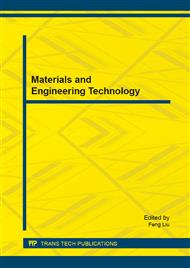[1]
D.N. Godard. Self-recovering equalization and carrier tracking in two-dimensional data communication systems[J]. IEEE Trans. on communication, 1980. 28: 1867-1875.
DOI: 10.1109/tcom.1980.1094608
Google Scholar
[2]
Zhang L. The research of blind equalization techniques in digital communication systems [D]. Beijing: Beijing Institute of Technology. (2003).
Google Scholar
[3]
You C, Hong D. Nonlinear blind equalization schemes using complex-valued multilayer feedforward neural networks[J]. Neural Networks, IEEE Transactions on, 1998, 9(6): 1442-1455.
DOI: 10.1109/72.728394
Google Scholar
[4]
K.I. Diamantaras,T. Papadimitriou.Analytical Solution of the Blind Identification Problem for Multichannel FIR Systems Based on Second Order Statistics[J].Acoustics,Speech and Signal Processing,2007.ICASSP 2007.IEEE International Conference on Volume 3,2007:III-749-752.
DOI: 10.1109/icassp.2007.366788
Google Scholar
[5]
Chen F, Kwong S, Nie W, et al. Blind IR Channel Equalization Based on Second-Order Statistics[C]/Vehicular Technology Conference, 2006. VTC 2006-Spring. IEEE 63rd. IEEE, 2006, 5: 2334-2338.
DOI: 10.1109/vetecs.2006.1683274
Google Scholar
[6]
Zhang X, Bao Z. Communication Signal Processing. [M]. Beijing: National Defence Industry Press, (2000).
Google Scholar
[7]
Cadzow J A. Blind deconvolution via cumulant extrema[J]. Signal Processing Magazine, IEEE, 1996, 13(3): 24-42.
DOI: 10.1109/79.489267
Google Scholar
[8]
D. R. Brillinger and M. Rosenblatt, Computation and interpretation of kth-order spectra, Spectral Analysis of Time Series[M], B. Harris, Editor, NYC, Wiley, 1967, 189-232.
Google Scholar
[9]
Zhang X. Study on blind equalization algorithm based on high-order spectrum theory [D]. Taiyuan: Taiyuan university of technology. (2003).
Google Scholar
[10]
A. Benveniste, M. Goursat , G. Ruget. Robust Identification of a Nonminimum Phase System: Blind Adjustment of a Linear equalizer in Data Communication[J]. IEEE Trans. on automatic control. 1980, 25:. 385~399.
DOI: 10.1109/tac.1980.1102343
Google Scholar


